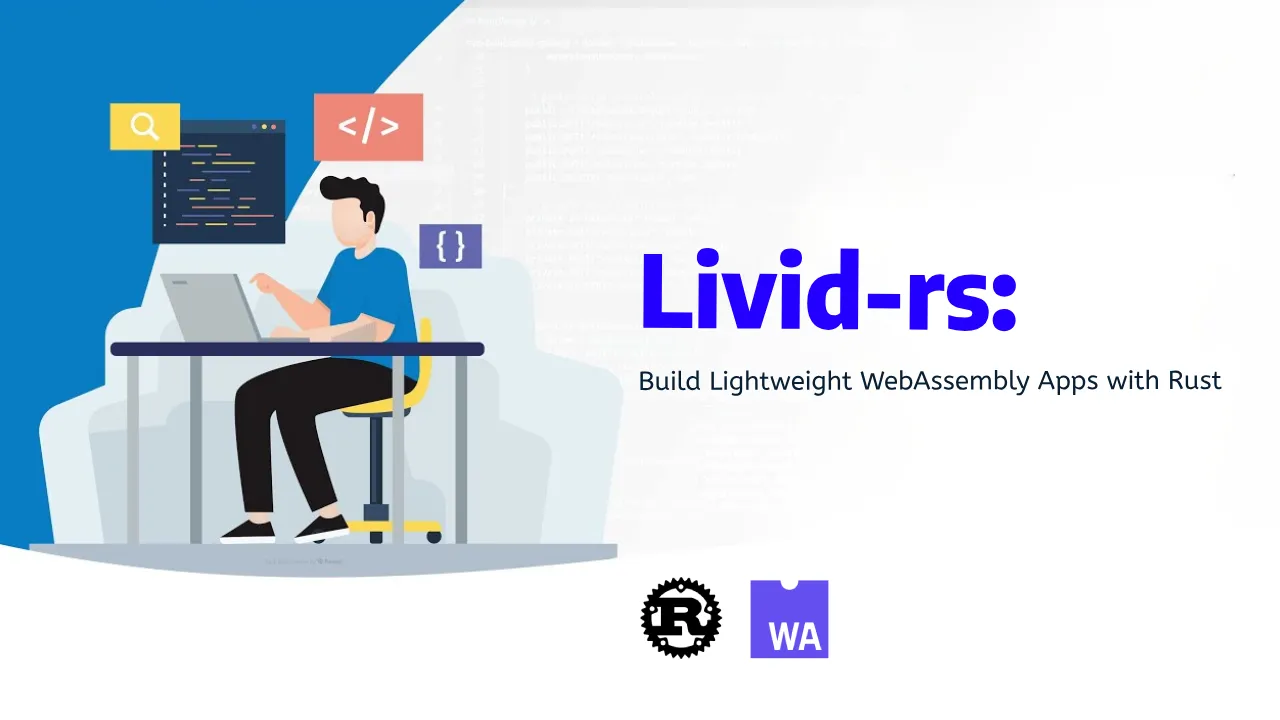Livid: Build Lightweight WebAssembly Apps with Rust
livid-rs
livid-rs is a Rust framework for creating frontend and backend wasm web apps (targetting browsers and desktop). It's composed of:
livid: A lightweight frontend Rust crate for creating web apps via webassembly. It provides the following advantagges:
- Backend agnostic.
- Thin wrapper around web-sys
- No vdom.
- No macros!
livid-cli: A lightweight build/dev tool which allows compiling your frontend into a web app or desktop app (via livid deploy). It can be invoked from the command line:
livid build
livid serve
# if targetting desktop
livid deploy livid-desktop: A minimal webview implementation in Rust, which allows deploying your wasm web app as desktop apps. It's also frontend agnostic.
livid-server: An internal server used in livid-cli and livid-desktop
Examples:
- Different architectures (low-level, widgets api, elm architecture).
- Fullstack livid application
- livid frontend with a wry backend.
livid
Requirements
- The wasm32-unknown-unknown target:
rustup target add wasm32-unknown-unknown
Usage
- Install the livid-cli crate (to simplify building and bundling your web app):
cargo install livid-cli
- You can add links to CSS files/urls, and use Widget::set_class_name() to benefit from CSS styling.
- Create a project:
[dependencies]
livid = "0.2"In your Rust source file:
use livid::{enums::*, prelude::*, *};
enum Action {
Increment(i32),
Decrement(i32),
}
fn btn(action: Action) -> button::Button {
let (label, color, step) = {
match action {
Action::Increment(v) => ("Increment", Color::Green, v),
Action::Decrement(v) => ("Decrement", Color::Red, -v),
}
};
let btn = button::Button::default().with_label(label);
btn.set_label_size(20);
btn.set_label_color(color);
btn.set_margin(10);
btn.set_padding(10);
btn.set_frame(FrameType::RFlatBox);
btn.add_callback(Event::Click, move |_| {
let frame = widget::Widget::from_id("result").unwrap();
let mut old: i32 = frame.text_content().unwrap().parse().unwrap();
old += step;
frame.set_text_content(Some(&old.to_string()));
});
btn
}
fn main() {
let col = group::Column::default_fill();
col.set_justify_content(AlignContent::Center);
btn(Action::Increment(1));
let f = frame::Frame::default().with_label("0").with_id("result");
f.set_padding(20);
f.set_label_size(20);
btn(Action::Decrement(1));
col.end();
}

- Build and serve using livid-cli:
livid build or livid serve
- Build a desktop app with wasm for the frontend using:
livid deploy --width=600 --height=400
Low-level api
Livid also a lower level widgets api:
use livid::{enums::*, prelude::*, *};
fn div() -> widget::Widget {
widget::Widget::new(WidgetType::Div)
}
fn btn(i: i32) -> widget::Widget {
let btn = widget::Widget::new(WidgetType::Button);
let (label, col) = if i > 0 {
("Increment", "Green")
} else {
("Decrement", "Red")
};
btn.set_text_content(Some(label));
btn.set_style(Style::Color, col);
btn.add_callback(Event::Click, move |_| {
let result = widget::Widget::from_id("result").unwrap();
let mut old: i32 = result.text_content().unwrap().parse().unwrap();
old += i;
result.set_text_content(Some(&old.to_string()));
});
btn
}
fn main() {
document::Document::get().set_title("Counter");
let btn_inc = btn(1);
let btn_dec = btn(-1);
let main_div = div();
main_div.append(&btn_inc);
main_div.append(&btn_dec);
let result = div();
result.set_id("result");
result.set_text_content(Some("0"));
result.set_style(Style::FontSize, "22px");
let btns = document::Document::get().get_elements_by_tag_name("BUTTON");
for btn in btns.iter() {
// set their fontSize to 22 pixesl
btn.set_style(Style::FontSize, "22px");
}
}
Low level example with CSS
use livid::{
document::Document,
enums::WidgetType::{self, *},
widget::Widget,
};
fn w(typ: WidgetType) -> Widget {
Widget::new(typ)
}
fn main() {
Document::get().set_title("Form");
Document::add_css_link("https://cdn.jsdelivr.net/npm/bulma@0.9.3/css/bulma.min.css");
Document::add_css_link("https://cdnjs.cloudflare.com/ajax/libs/font-awesome/4.7.0/css/font-awesome.min.css");
let form = w(Form);
form.set_class_name("box");
form.append(&{
let div = w(Div);
div.set_class_name("field");
div.append(&{
let label = w(Label);
label.set_class_name("label");
label.set_inner_html(r#"<span class='fa fa-envelope'></span> Email"#);
label
});
div.append(&{
let div = w(Div);
div.set_class_name("control");
div.append(&{
let inp = w(Input);
inp.set_class_name("input");
inp.set_attribute("type", "email").unwrap();
inp.set_attribute("placeholder", "m@gmail.com").unwrap();
inp
});
div
});
div
});
}

Higher-level api
Livid is unopinionated. You can build higher-level abstractions on top:
mod detail; // we define an OnEvent trait for our buttons
use crate::detail::{OnEvent, App, Settings};
use livid::{enums::*, prelude::*, *};
#[derive(Default, Copy, Clone)]
struct Counter {
value: i32,
}
#[derive(Debug, Clone, Copy)]
enum Message {
IncrementPressed,
DecrementPressed,
}
impl App for Counter {
type Message = Message;
fn new() -> Self {
Self::default()
}
fn title(&self) -> String {
String::from("Counter - livid")
}
fn update(&mut self, message: Message) {
match message {
Message::IncrementPressed => {
self.value += 1;
}
Message::DecrementPressed => {
self.value -= 1;
}
}
}
fn view(&mut self) {
let col = group::Column::default_fill();
button::Button::default()
.with_label("Increment")
.on_trigger(Message::IncrementPressed);
frame::Frame::default().with_label(&self.value.to_string());
button::Button::default()
.with_label("Decrement")
.on_trigger(Message::DecrementPressed);
col.end();
}
}
fn main() {
Counter::new().run(Settings {
size: (300, 200),
win_color: Some(Color::Rgb(Rgb(250, 250, 250))),
..Default::default()
})
}
Check the examples directory for fuller examples.
livid-cli
livid-cli builds and bundles your wasm web app.
Installation
cargo install livid-cli
Requirements
- wasm32-unknown-unknown target:
rustup target add wasm32-unknown-unknown
- Wasm-bindgen:
cargo install wasm-bindgen-cli
- Wasm-opt (optional, wasm-opt is called if found in PATH and the --release flag is passed to
livid build).
It can be downloaded from the binaryen repo's releases.
Usage
USAGE:
livid <SUBCOMMAND>
SUBCOMMANDS:
build Build your wasm web app
clean Clean output artifacts
serve Serve the generated index.html
deploy Creates a desktop app using the wasm web app for frontend
--help Prints this message or the help of the given subcommand(s)
From the manifest directory of your wasm rust applications directory, run: livid build or livid build --release
It should generate a dist folder in the manifest directory. The generated html index file can then be served by any server or by running livid serve. If you prefer to use another server for development, pass the dist directory to the server: python3 -m http.server --dir dist
If livid-cli finds an index.html shell in the manifest directory, it will use it and replace the {{SCRIPT}} placeholder (à la emscripten shell html) with a script to load the generated js glue code.
<html>
<head>
<meta charset="utf-8">
<meta http-equiv="Content-Type" content="text/html; charset=utf-8">
<meta name="viewport" content="width=device-width, initial-scale=1.0">
</head>
<body>
{{SCRIPT}}
</body>
</html>
To create a desktop app:
livid deploy --width=800 --height=600 --title="app name"
livid-desktop
Usage
livid-desktop = "0.1"
In your main.rs
use livid_desktop::{App, Settings};
fn main() {
let a = App::new(Settings {
w: 600,
h: 400,
title: "My App",
fixed: true,
port: 8080, // the default
dist_folder: PathBuf::from("dist"), // the default
..Default::default()
});
a.run();
}
The dist folder should contain the index.html plus the wasm and javascript glue code.
Requirements
- On Windows: No other dependencies.
- On MacOS: No other dependencies.
- On X11/wayland platforms, webkit2gtk:
- Debian-based distros: sudo apt-get install libwebkit2gtk-4.0-dev.
- RHEL-based distros: sudo dnf install webkit2gtk3-devel.
Download details:
Author: moalyousef
Source: https://github.com/moalyousef/livid-rs
License: MIT license
